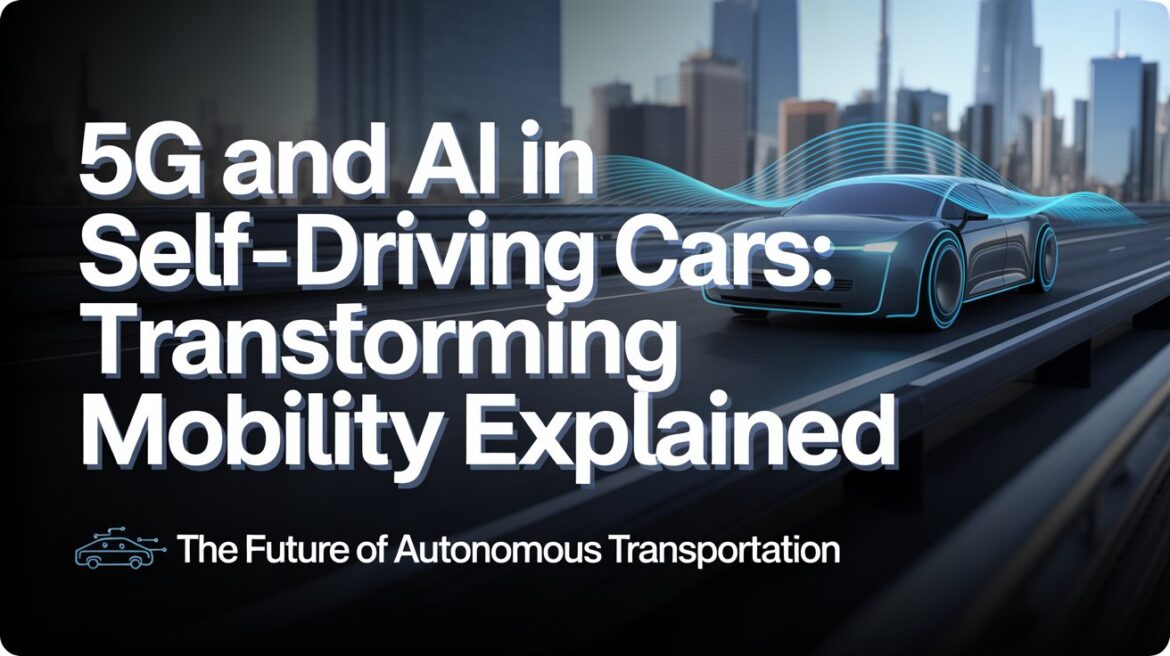Self-driving cars represent one of the most transformative applications of modern technology, promising safer roads, reduced congestion, and new mobility services. Two innovations lie at the heart of this revolution: 5G connectivity and Artificial Intelligence (AI). While 5G delivers the ultra-low latency, high bandwidth, and massive device density needed for real-time vehicle networking, AI provides the perception, prediction, and planning capabilities essential for autonomous driving. Together, they create a synergistic ecosystem that accelerates deployment and enhances performance. In this post, we’ll explore how 5G and AI work individually and in tandem to power self-driving cars, discuss key challenges, and look ahead at future developments.
The Role of 5G in Autonomous Vehicles
1. Ultra-Low Latency Communication
5G networks can achieve end-to-end latencies as low as 1 millisecond—an order of magnitude faster than 4G LTE. For self-driving cars, every millisecond counts. Low latency enables:
- Cooperative Perception: Vehicles share sensor data (LiDAR, cameras, radar) in real time to see beyond their own line of sight.
- Teleoperations: Remote operators can intervene or assist in complex scenarios, relying on near-instant feedback.
- Edge-Based AI: Critical inference tasks can run on edge servers, reducing on-board compute requirements without sacrificing responsiveness.
2. Enhanced Bandwidth for Rich Sensor Streams
Modern autonomous vehicles generate terabytes of data per hour from high-resolution cameras, LiDAR point clouds, and radar. 5G’s multi-gigabit-per-second capacity supports:
- High-Definition Mapping Updates: Continuous streaming of real-time HD maps ensures accurate localization.
- Over-The-Air (OTA) Software & Model Updates: Fast downloads of large AI model files and firmware upgrades keep vehicles up to date.
- HD Video Sharing: Live video feeds between vehicles and control centers enhance monitoring and diagnostics.
3. Massive Device Connectivity
5G’s ability to support up to a million devices per square kilometer allows for a dense network of connected vehicles, roadside units, and infrastructure sensors—forming the backbone of V2X (vehicle-to-everything) communication.
The Role of AI in Autonomous Driving
1. Perception and Sensor Fusion
AI algorithms—particularly deep neural networks—analyze raw sensor data to detect objects, classify road users, and segment drivable space. Sensor fusion combines inputs from cameras, LiDAR, and radar to:
- Improve Detection Accuracy: Mitigate weaknesses of individual sensors (e.g., cameras in low light, radar in cluttered environments).
- Provide Redundancy: Ensure safety through multiple independent detection channels.
2. Prediction and Behavior Modeling
Machine learning models forecast the future trajectories of pedestrians, cyclists, and other vehicles. Accurate prediction is vital to:
- Plan Safe Maneuvers: Decelerate or change lanes proactively when a bicyclist appears likely to cut across.
- Optimize Smoothness: Reduce harsh braking and acceleration by anticipating traffic flow.
3. Decision Making and Motion Planning
Reinforcement learning and search-based planners help vehicles choose optimal paths while respecting traffic rules, comfort constraints, and safety margins. AI-driven planners excel at:
- Complex Urban Scenarios: Navigating intersections, roundabouts, and construction zones.
- Adaptive Strategies: Balancing efficiency (shortest route) with passenger comfort and energy consumption.
Synergy: How 5G and AI Work Together
- Distributed Intelligence
- Edge-Cloud Collaboration: Lightweight AI models run on-board for immediate reactions; heavier analytics execute on edge/cloud servers accessed via 5G.
- Collaborative Learning: Vehicles share anonymized driving data over 5G to federated-learn improved AI models without centralizing raw data.
- Cooperative Awareness
- Platooning: Groups of vehicles travel closely together at highway speeds, coordinating acceleration and braking via 5G links, while AI ensures safe inter-vehicle distances.
- Hazard Notification: Real-time alerts about slippery roads or hazards propagate instantly to nearby cars.
- Resilience and Redundancy
- Fallback Paths: If on-board AI encounters uncertainty (e.g., heavy fog), the vehicle can offload perception tasks to a remote server via 5G.
- Continuous Monitoring: AI health checks run at the edge, with 5G providing rapid telemetry to central monitoring platforms.
Challenges and Considerations
| Challenge | Mitigation Strategy |
|---|---|
| Coverage Gaps | Blend 5G with LTE/DSRC for hybrid connectivity. |
| Network Congestion | Prioritize V2X traffic using network slicing. |
| Security & Privacy | Employ end-to-end encryption and mutual authentication. |
| Compute Costs | Optimize AI models for edge deployment; use hardware accelerators. |
| Regulatory Uncertainty | Collaborate with standards bodies (3GPP, SAE) for unified frameworks. |
Future Outlook
- 6G and Beyond: Research into 6G promises even lower latency (<0.1 ms), terahertz bandwidths, and integrated sensing-communication capabilities that may render vehicles themselves as extended sensor arrays for smart cities.
- AI Hardware Evolution: Specialized automotive GPUs and NPUs will enable more complex AI inference on-board, reducing reliance on edge servers.
- Autonomous Mobility Services: The combination of 5G and AI will accelerate the rollout of robo-taxis, robo-delivery fleets, and cooperative freight convoys, transforming urban logistics and transportation.
Conclusion
The convergence of 5G and AI is catalyzing the rise of truly autonomous vehicles capable of safer, more efficient, and more connected mobility. 5G provides the real-time, high-bandwidth network fabric, while AI delivers the brains—enabling vehicles to perceive, predict, and plan in dynamic environments. Despite challenges around infrastructure, security, and regulation, ongoing advancements in both domains are rapidly closing the gap to widespread deployment. For automakers, telecommunication providers, and urban planners alike, understanding this synergy is key to unlocking the full potential of self-driving cars in the years ahead.
